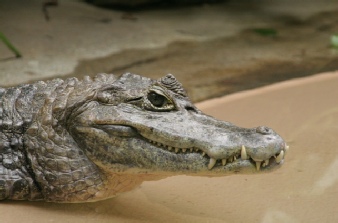



Unique Reptile Parties and Shows
Snakes, Lizards, Giant Tortoises and Crocs
07792491044

SPECTACLED CAIMAN
 The spectacled caiman Latin name caiman crocodilus, also known as the white caiman
or common caiman, is a crocodilian reptile found in much of Central and South America.
It lives in a range of lowland wetland and riverine habitat types and can tolerate
salt water as well as fresh; due in part to this adaptability it is the most common
of all crocodilian species. The spectacled caiman is a small to mid-sized crocodilian.
Males of the species are generally 1.8 to 2 m (5.9 to 6.6 ft), while females are
smaller, usually around 1.2–1.4 m (3.9–4.6 ft). The body mass of most adult spectacled
caimans is between 7 and 40 kg (15 and 88 lbs). The maximum reported size for the
species is 2.5 m (8.2 ft), with a body mass of 58 kg (130 lb). The largest female
was reportedly 1.61 m (5.3 ft) long and weighed 20 kg (44 lb). Caimans from the Venezuelan
llanos are reportedly larger-bodied than specimens from Mexico. The species' common
name comes from a bony ridge between the eyes, which gives the appearance of a pair
of spectacles. The spectacled caiman is a gray-green coloration, this species has
been known to change color. During colder weather the black pigment, found within
their skin cells, will expand making them appear darker.
The spectacled caiman Latin name caiman crocodilus, also known as the white caiman
or common caiman, is a crocodilian reptile found in much of Central and South America.
It lives in a range of lowland wetland and riverine habitat types and can tolerate
salt water as well as fresh; due in part to this adaptability it is the most common
of all crocodilian species. The spectacled caiman is a small to mid-sized crocodilian.
Males of the species are generally 1.8 to 2 m (5.9 to 6.6 ft), while females are
smaller, usually around 1.2–1.4 m (3.9–4.6 ft). The body mass of most adult spectacled
caimans is between 7 and 40 kg (15 and 88 lbs). The maximum reported size for the
species is 2.5 m (8.2 ft), with a body mass of 58 kg (130 lb). The largest female
was reportedly 1.61 m (5.3 ft) long and weighed 20 kg (44 lb). Caimans from the Venezuelan
llanos are reportedly larger-bodied than specimens from Mexico. The species' common
name comes from a bony ridge between the eyes, which gives the appearance of a pair
of spectacles. The spectacled caiman is a gray-green coloration, this species has
been known to change color. During colder weather the black pigment, found within
their skin cells, will expand making them appear darker.
The spectacled caiman will reach sexual maturity anywhere from 4 to 7 years. Usually the more dominant individuals will mature more quickly. They will gather and mate during the dry season. After mating season ends the females will build nests out of dense vegetation. The size of the nest varies depending on the resources available to the female. Each female can lay up to forty eggs. The larger females have recently been found to lay eggs that are larger than the eggs smaller females lay. Most Caimans will nest during the wet season. It is very unusual to see a Caiman nest during any winter months. The temperature is too low for the eggs.
Temperature is important to the developing eggs. Females will build their nests in a way that insulates them from extreme temperature changes. The nests are made of vegetation. As the vegetation decays the nests produce heat which can keep the eggs about five degrees warmer than if they were insulated by mud alone. Temperature not only incubates the eggs, but also determines the sex of the developing Caiman. Caiman do not possess the genes necessary to determine sex. They depend on temperature. When the temperature inside the nest is approximately 31 degrees Celsius, or lower, the Caiman will become male. However, when the temperature is approximately 32 degrees Celsius or higher they become female. Young Caiman do not hatch with the dark green coloring of their parents. They are yellow with black spots. This coloration will eventually fade away.
Spectacled caiman have strongly protective maternal behaviour. They raise their young in crèches, one female taking care of her own as well as several others' offspring. They will take care of their young for the first two to four months after the eggs hatch. This is the time it takes for the floods of the wet season to subside.
This species benefits from over-hunting of competitive species who occupy the same home range. This allows them access to resources normally would have been lost to these other species. Their skin is not wanted for leather production because their skin contains osteoderms. The only skin on their body which does not contain osteoderms are their sides. Therefore hunting of this species is relatively low. In most countries, hunting this species is legal. Venezuela permits hunting every fall, providing the number of kills does not exceed 150,000 for that season. The skin that is salvageable, will be harvested. It is commonly found sold in the American market, sometimes mislabelled as Alligator Mississippiensis.
There are about four million Common Caiman found in Venezuela. Recent surveys show that the population is expected to continue to increase. This is an example of how well the species is able to adapt. However, it is difficult to determine how well the species is doing on a global scale since populations are not doing well in other countries including Peru and El Salvador. Despite being commonly mistaken as this species, the incredibly large population of caiman living within the Brazilian Pantanal are a separate species, the Yacare Caiman. More up-to-date surveys are required for clarification, and to examine the interactions between the different subspecies. Further taxonomic work would make control measures easier to implement, as currently identification of different subspecies can be difficult. The major threat to this species and its subspecies is currently illegal hunting. Smuggling rings operating through Thailand and Singapore are extremely damaging to individual populations, and greater control measures and more effective legislation are needed.
According to the Crocodilian Species List: "The subspecies caiman crocodilus apaporiensis is under severe threat in Colombia. Feral populations of caiman crocodilus are creating problems for other species of crocodilians and native wildlife, however. These populations have become established in three countries. The introduced population in Cuba is thought to have been primarily responsible for the dramatic decline and probable disappearance of Crocodylus Rhombifer from the Isla de la Juventud."
Conservation programs are utilized in many countries. The most common form of conservation is the use of cropping, or manually the reducing numbers of several wild, and abundant species. Long-term effects have yet to be discovered; more surveys have been recommended. There are also Farming or ranching programs, however, they seem to be more expensive and possibly less effective.
Caimans eat a variety of invertebrates such as insects, crustaceans, and mollusks. The larger caimans will eat fish and water snails. Older animals are capable of taking larger, mammalian prey (e.g. wild pigs). Observations show that as conditions become drier, caimans stop feeding. In areas where this species has become depleted, fish populations have also shown a decline. Until recently, it was thought that the caiman crocodilus would over eat the fish and snail populations. Some suggest that they control piranha populations. However, piranhas have not been found to be a normal meal. The Yacare Caiman does demonstrate this particular dietary preference. In reality, it is likely that The Spectacled Caiman is very much a generalist and adaptive predator, given its ecological success.